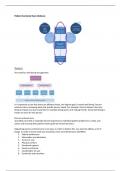Summary
Summary Patient Centered Care Delivery - everything
- Course
- Institution
This is a summary of Patient Centered Care Delivery of the master HCM. It contains all lectures with notes, a summary of all literature and everything of all workgroups. I had a 9,0 for the exam. So, I hope this helps you as well!
[Show more]



